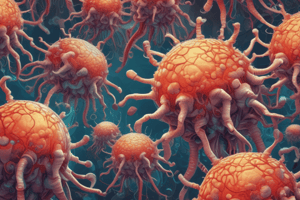Podcast
Questions and Answers
What are common symptoms associated with coronaviruses?
What are common symptoms associated with coronaviruses?
- Chest pain and dizziness
- Nausea and vomiting
- Fever and cough (correct)
- Diarrhea and rash
How can human coronaviruses primarily spread?
How can human coronaviruses primarily spread?
- Airborne transmission from cooking
- Coughing and sneezing (correct)
- Touching books and paper
- Contaminated food and water
Which statement about immunity to coronaviruses is accurate?
Which statement about immunity to coronaviruses is accurate?
- Immunity does not persist (correct)
- Immunity lasts a lifetime after infection
- Re-infection is not possible within a year
- Immunity increases with multiple infections
What is a significant characteristic of the coronavirus spike protein?
What is a significant characteristic of the coronavirus spike protein?
When was COVID-19 first declared a pandemic by the WHO?
When was COVID-19 first declared a pandemic by the WHO?
What is the primary mode of transmission for arboviruses?
What is the primary mode of transmission for arboviruses?
Which of the following viruses belongs to the Flavivirus genus?
Which of the following viruses belongs to the Flavivirus genus?
What clinical feature is associated with neuroinvasive diseases caused by arboviruses?
What clinical feature is associated with neuroinvasive diseases caused by arboviruses?
What type of treatment is typically provided for arbovirus infections?
What type of treatment is typically provided for arbovirus infections?
Which of the following prevention strategies is effective against arboviruses?
Which of the following prevention strategies is effective against arboviruses?
Flashcards are hidden until you start studying
Study Notes
Arboviruses
- Arboviruses are viral infections transmitted to humans by arthropods such as fleas, ticks, and mosquitoes.
- Key genera causing human infections include:
- Flavivirus: Yellow fever, West Nile virus, Zika virus, Dengue fever, Japanese encephalitis.
- Togavirus: Ross River virus, Eastern equine virus, Western equine virus.
- Bunyavirus: California encephalitis, La Crosse virus, Jamestown Canyon virus.
Transmission
- Spread through insect bites, blood transfusion, organ transplant, sexual contact, pregnancy, and childbirth.
Clinical Features
- Neuroinvasive diseases: Symptoms include meningitis, fever, headache, stiff neck, muscle pain, confusion, weakness, seizures.
- Non-neuroinvasive diseases: Symptoms include fever, headache, muscle aches, joint pain, gastrointestinal distress, rash.
Epidemiology
- Globally distributed; warm climates support year-round transmission.
Diagnosis
- Common methods include ELISA and Polymerase Chain Reaction (PCR).
Treatment
- Most infections require supportive care; no specific antiviral treatments.
Prevention and Control
- Vaccines available for some arboviruses (e.g., Japanese encephalitis, yellow fever).
- Preventive measures include using insect repellent and wearing protective clothing.
Coronaviruses
- A large family of respiratory viruses includes COVID-19, MERS, and SARS.
- These viruses often circulate among animals like camels, cats, and bats.
- COVID-19 (SARS-CoV-2) emerged in Wuhan, China in 2019 and was declared a pandemic.
Transmission
- Spread through respiratory droplets from coughs/sneezes, direct contact, surface contact, or touching face after contacting contaminated surfaces.
Clinical Features
- Symptoms commonly include fever, cough, headache, runny nose, and severe cases lead to pneumonia or bronchitis, particularly in vulnerable populations.
Epidemiology
- Winter outbreaks are common; immunity does not last, leading to potential re-infections.
Diagnosis
- Diagnosed via ELISA and PCR.
Treatment
- Symptomatic relief includes pain medications, hydration, and rest.
Prevention and Control
- Preventative measures: Vaccination, wearing masks, hand hygiene, and avoiding close contact with sick individuals.
Retroviruses
- Retroviruses insert a DNA copy of their RNA genome into the host cell, using reverse transcriptase.
- Key types include HIV (causes AIDS), HTLV (causes leukemia), and benign spumaviruses.
Transmission
- Mainly through vertical transmission (mother to child) during childbirth or breastfeeding.
- Other routes include unprotected sexual contact and transmission via blood or medical procedures.
Clinical Features
- Initial flu-like symptoms (seroconversion illness) such as fever and malaise occur 2-6 weeks post-exposure.
- Symptomatic HIV presents with weight loss, high fever, diarrhea, and frequent opportunistic infections.
Diagnosis
- Identified through ELISA and PCR.
Treatment
- Treated with antiretroviral drugs; HAART employs a combination of multiple drugs to combat HIV.
Studying That Suits You
Use AI to generate personalized quizzes and flashcards to suit your learning preferences.




